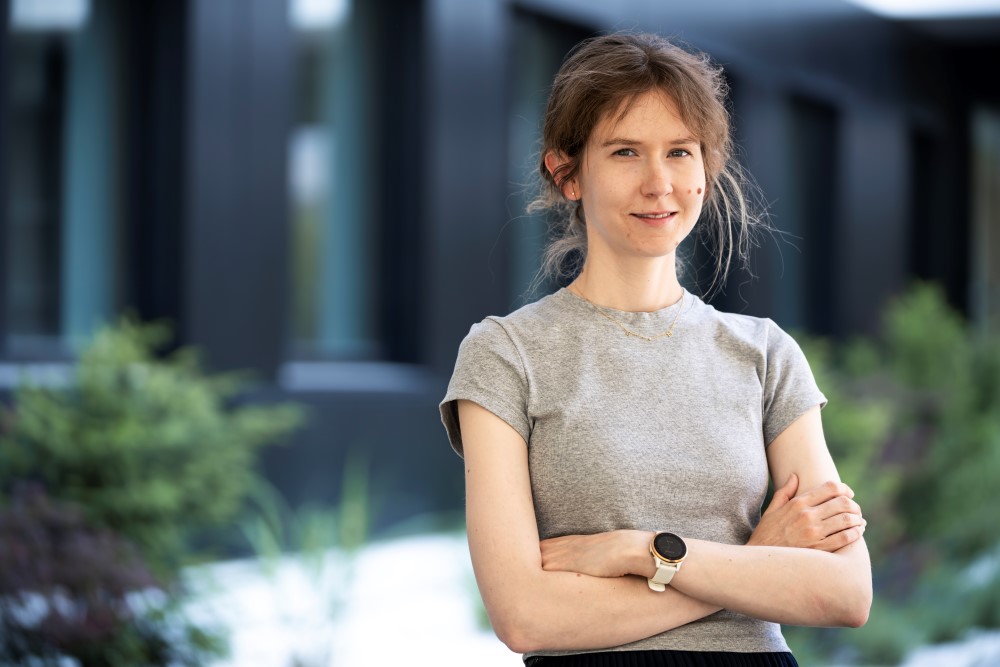June 30, 2025
Of Mice and Mind
New Assistant Professor Amelia Douglass tries to decode brain-body conversations in mice
In June, Australian neuroscientist Amelia Douglass joined the Institute of Science and Technology Austria (ISTA) from Harvard Medical School as an Assistant Professor. Together with her team, she uncovers mysteries of survival instincts by studying how mice and their brains respond to environmental threats. This potentially offers insights into stress and anxiety in humans.

A mouse wanders through the garden onto the patio, looking for things to snack on. It scans its surroundings—left, right, then left again—and continues its way. From inside the house, a lazy yet ever-alert orange checkered cat just woke up from its nap and immediately senses the mouse. The cat quickly runs through the open door onto the patio. Confronted by its predator, the mouse freezes, assesses the situation, makes a split-second decision, and attempts to flee, zigzagging through the garden, looking for a nearby shelter to hide.
What drives these behaviors?
Those flexible and rapid behaviors are accompanied by physiological changes driven by the brain: increased heart rate, blood pressure, and respiration. These are essential for meeting the heightened energy demands during stress.
Amelia Douglass, new Assistant Professor at the Institute of Science and Technology Austria (ISTA) in Klosterneuburg, is investigating how animals adapt to their environment to ensure survival. “We especially want to understand how the brain simultaneously coordinates running away from a predator while at the same time adapting its heart rate and blood pressure,” she explains.

Working with her team, the neuroscientist aims to gain a holistic view of how the brain ‘talks’ to the internal organs to control the body in response to threats. To do this, they use mice as model organisms. They perform in vivo (within the living organism) imaging of the activity of neurons in the brain, alter neural activity, and closely observe behavior and body functions. This helps them to understand how the brain is organized to respond to threats and how its response can change over time.
Their findings will shed light on the function of the brain to ensure the survival of the organism. “Once we achieve these goals, I hope that what we learn could be useful for humans as well, especially understanding how such survival adaptations become disrupted in stress and anxiety,” Douglass continues.

The interface between body and brain
The team is particularly focused on one specific area in the brain: the hypothalamus. Despite its small size, it is essential for regulating the body’s functions and maintaining homeostasis—the body’s internal balance. It achieves this by communicating with the peripheral nervous system, the endocrine system, and motor brain areas.
“We want to understand how the hypothalamus is organized to sense environmental challenges like threats and control bodily adaptations,” Douglass explains. “We also aim to decipher the mechanisms that quickly execute these adaptations when a threat is encountered but keep them in check when threats aren’t around.” Additionally, Douglass hopes to explore how these threat responses change based on the animal’s internal state, such as hunger or sickness, or the time of day.
From Australia to Austria
Born and raised in Australia, Amelia Douglass earned her Bachelor’s at the University of Queensland, Australia, before moving to Munich, Germany, to complete her PhD with Ruediger Klein at the Max Planck Institute for Neurobiology. Afterwards, she conducted her postdoc in Boston, working closely with Brad Lowell at Beth Israel Deaconess Medical Center, Harvard Medical School.

Now an Assistant Professor at the Institute of Science and Technology Austria (ISTA), she is in the process of setting up her first lab. She is currently looking for motivated PhD students and postdocs to join in exploring how the brain controls the body to maintain homeostasis.
When asked about what keeps her energized, Douglass says, “Since science can be unpredictable, I enjoy activities that have a more predictable journey and ending, like baking and hiking.” Both activities can be enjoyed at ISTA, with the Vienna Woods right around the corner and the “Baking lab” team members always eager for new, tasty pastries.



